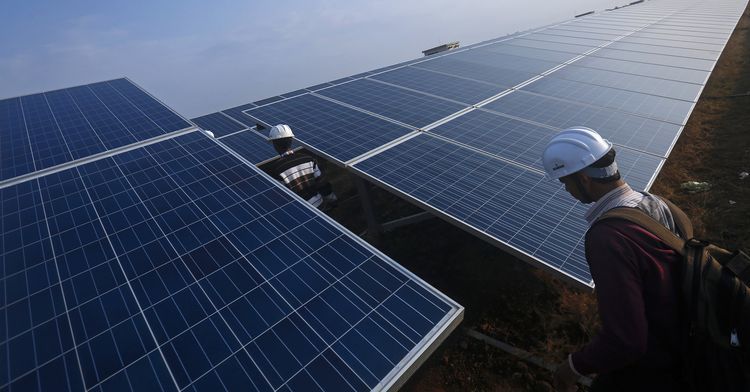
The spectacular failure of what was once the world’s biggest renewable-energy company has turned into a smorgasbord of wind and solar farms being gobbled up by infrastructure investors, clean-power developers and even a vegan soccer team.
Since filing the largest U.S. bankruptcy of 2016, SunEdison Inc. has hosted the biggest-ever sale of renewables assets. It’s shed at least $1 billion of assets from Southern California to Chile to India — some through record-breaking deals — including projects that would have died without new owners. With wind and solar supplying more than 11 percent of global electricity, the company’s debt-induced collapse enabled competitors to strengthen their existing hands or enter new markets.
“Developers have been picking at the carcass,” Nathan Serota, a New York-based analyst at Bloomberg New Energy Finance, said in an interview. “As it turns out, the carcass was not so bad.”
Based in Maryland Heights, Missouri, SunEdison amassed its portfolio by taking advantage of clean-energy’s push into the mainstream. Its financial engineering helped enable wind and solar to make up more than half of all new power-plant capacity in the U.S. in the past decade. In the process, the company piled up $16.1 billion in liabilities by the time it sought court protection from creditors on April 21, a year ago next week.
Its ascent was marked by landmark acquisitions announced in the first seven months of 2015, making SunEdison a key driver for the clean-energy ambitions of some developing countries, including India.
Now, it’s looking at how to make a comeback. After toggling between a wind-down or a reorganization since filing for bankruptcy, it announced last month a rough outline for restructuring. But it’s also sold off so many prized assets and lost key staff that questions remain about what of value will be left.
“They’re not coming back as anything material, just the rump or shadow of their former self,” Swami Venkataraman, a New York-based analyst at Moody’s Investors Service, said last month.
SunEdison didn’t offer any official comment.
Bulk Deals
Whether or not SunEdison prospers, its assets have found loving owners.
Its piecemeal sales process started tentatively, but it soon became clear that bulk transactions were preferred. That meant fewer deals, a plus considering SunEdison had at one point marketed several gigawatts of assets. That favored large companies able to cope with large-scale finance and project development, including the U.S.’ largest independent power producer, NRG Energy Inc.
“They could look at us with a high degree of transaction-certainty,” Craig Cornelius, NRG’s San Francisco-based senior vice president of renewables. “Otherwise, they would have needed four different buyers for the same portfolio.”
NRG in November bought about 1.5 gigawatts of wind and solar projects — its biggest-ever clean-power acquisition — for as much as $183 million, depending on certain milestones. That saved three solar farms in Hawaii that a local utility had effectively halted, citing SunEdison’s uncertain status.
In March, SunEdison one-upped itself with twin deals that would together represent the biggest-ever transfer of operating clean-power plants — 4 gigawatts of wind and solar farms. Those transactions would shift its TerraForm yieldcos to Brookfield Asset Management Inc., Canada’s largest alternative-asset manager, valuing the two entities at $2.49 billion.
The deals would make Brookfield — the owner of about 10,700 megawatts of clean-energy plants globally — a major solar force. Brookfield today owns a half-megawatt of solar, enough to power just 82 U.S. homes.
SunEdison’s aggressive bids in 2015 helped drive down solar tariffs in India, and its bankruptcy shocked the country that saw a big western company’s presence as a vote of confidence in its renewables goals.
Greenko Energies Pvt., an Indian developer backed by sovereign wealth funds of Abu Dhabi and Singapore, emerged to fill the void. In January, it bought about 1.7 gigawatts of solar assets from SunEdison, valued at about $500 million.
About 440 megawatts were in operation and another 1.2 gigawatts in development. The acquisition will help Greenko expand its generation capacity to about 5 gigawatts in the next two years, said Mahesh Kolli, its founder.
With insolvency looming, SunEdison sold 198 megawatts of solar assets in Japan to BCPG. The deal accelerated BCPG’s clean-energy efforts, which date to its 2015 acquisition of solar projects in Thailand. It had already been evaluating Japan, and the SunEdison portfolio helped it establish itself there.
Actis LLP, a London-based private equity firm, also used SunEdison assets to expand with a deal this year for a 1.5-gigawatt portfolio of Latin American solar projects. It wants to invest $525 million in renewable energy across Latin America, with a focus on Brazil, Mexico, Uruguay and Chile.
In the U.K., meanwhile, the Forest Green Rovers Football Club Ltd., purchased SunEdison’s residential rooftop business shortly before the bankruptcy filing.
Forest Green Rovers, a vegan soccer team based in Gloucestershire, is owned by the clean-energy supplier Ecotricity Group Ltd. Chairman Dale Vince, who wants his club to be the greenest in the world, is building a new stadium made almost entirely of wood, and already uses a solar-powered robot lawnmower.
Scale
In late December through the first quarter, SunEdison closed more than $250 million in deals, according to a bankruptcy filing.
“What made it exceptional was the scale of the overall portfolio — that it included every stage of development, that it covered every imaginable geography,” NRG’s Cornelius said. “That was the result of the expansion SunEdison had taken.”